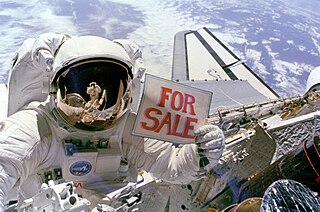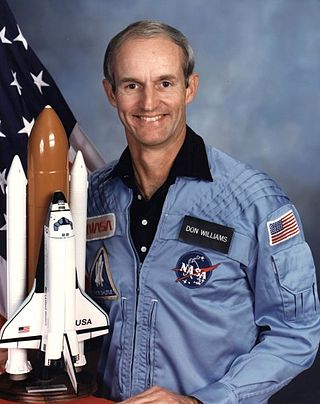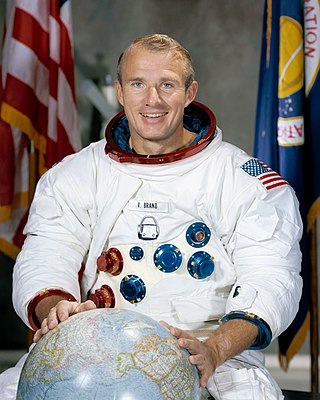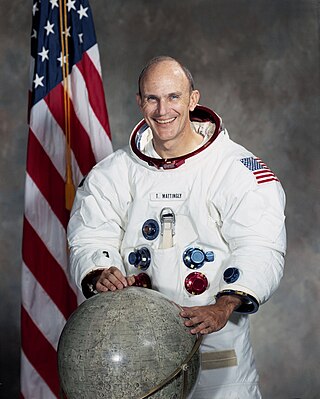Syncom started as a 1961 NASA program for active geosynchronous communication satellites, all of which were developed and manufactured by the Space and Communications division of Hughes Aircraft Company. Syncom 2, launched in 1963, was the world's first geosynchronous communications satellite. Syncom 3, launched in 1964, was the world's first geostationary satellite.

STS-41-C was NASA's eleventh Space Shuttle mission, and the fifth mission of Space Shuttle Challenger. The launch, which took place on April 6, 1984, marked the first direct ascent trajectory for a Space Shuttle mission. During the mission, Challenger's crew captured and repaired the malfunctioning Solar Maximum Mission satellite, and deployed the Long Duration Exposure Facility (LDEF) experimental apparatus. STS-41-C was extended one day due to problems capturing the Solar Max satellite, and the landing on April 13, 1984, took place at Edwards Air Force Base, instead of at Kennedy Space Center as had been planned. The flight was originally numbered STS-13.

James Donald "Wxb" Wetherbee, is a retired United States Navy officer and aviator, test pilot, aerospace engineer, and NASA astronaut. He is a veteran of six Space Shuttle missions and is the only American to have commanded five spaceflight missions.

STS-51-A was the 14th flight of NASA's Space Shuttle program, and the second flight of Space Shuttle Discovery. The mission launched from Kennedy Space Center on November 8, 1984, and landed just under eight days later on November 16, 1984.

STS-51-I was the 20th mission of NASA's Space Shuttle program and the sixth flight of Space Shuttle Discovery. During the mission, Discovery deployed three communications satellites into orbit. The mission launched from Kennedy Space Center, Florida, on August 27, 1985, and landed at Edwards Air Force Base, California, on September 3, 1985.

Michael Lloyd Coats is a former NASA astronaut, raised in Riverside, California. From December 2005 to December 2012, he served as Director of the Johnson Space Center in Houston, Texas.

Frederick Hamilton "Rick" Hauck is a retired captain in the United States Navy, a former fighter pilot and NASA astronaut. He piloted Space Shuttle mission STS-7 and commanded STS-51-A and STS-26.

Dale Allan Gardner was a NASA astronaut, and naval flight officer who flew two Space Shuttle missions during the mid 1980s.

Karol Joseph "Bo" Bobko was an American aerospace engineer, U.S. Air Force officer, test pilot, and a USAF and NASA astronaut. Bobko was the first graduate of the U.S. Air Force Academy to travel in space and the first person to fly on a space shuttle on three different missions: STS-6, STS-51-D, STS-51-J.

Donald Edward Williams was an American naval officer and aviator, test pilot, mechanical engineer and NASA astronaut. He logged a total of 287 hours and 35 minutes in space.

Vance DeVoe Brand is an American naval officer, aviator, aeronautical engineer, test pilot, and NASA astronaut. He served as command module pilot during the first U.S.-Soviet joint spaceflight in 1975, and as commander of three Space Shuttle missions.

Richard Oswalt Covey is a retired United States Air Force officer, former NASA astronaut, and a member of the United States Astronaut Hall of Fame.

Daniel Charles Brandenstein is the Executive Vice President and Chief Operating Officer of United Space Alliance. He is a former Naval Aviator, test pilot and NASA astronaut, who flew four Space Shuttle missions. He also served as Chief of the Astronaut Office from 1987 to 1992.

Terry Jonathan "T. J." Hart is an American mechanical and electrical engineer, a retired United States Air Force lieutenant colonel and pilot, and former NASA astronaut. Hart served as a mission specialist on the STS-41-C mission, where tasks included operation of the shuttle Remote Manipulator System (RMS) arm to deploy the Long Duration Exposure Facility (LDEF) and Solar Max satellite.

David Mathieson Walker, , was an American naval officer and aviator, fighter pilot, test pilot, and a former NASA astronaut. He flew aboard four Space Shuttle missions in the 1980s and 1990s.

Thomas Kenneth Mattingly II was an American aviator, aeronautical engineer, test pilot, rear admiral in the United States Navy, and astronaut who flew on Apollo 16 and Space Shuttle STS-4 and STS-51-C missions.

John Michael "Mike" Lounge was an American engineer, a United States Navy officer, a Vietnam War veteran, and a NASA astronaut. A veteran of three Space Shuttle flights, Lounge logged over 482 hours in space. He was a mission specialist on STS-51-I (1985) and STS-26 (1988) and was the flight engineer on STS-35 (1990).

George David Low was an American aerospace executive and a NASA astronaut. With undergraduate degrees in physics and mechanical engineering and a master's degree in aeronautics and astronautics, he worked in the Jet Propulsion Laboratory (JPL) at the California Institute of Technology in the early 80's, before being picked as an astronaut candidate by NASA in 1984. In addition to holding some technical assignments, he logged more than 700 hours in space, before he left NASA in 1996 to pursue a career in the private sector. He was the son of George M. Low, the manager of the Apollo Spacecraft Program Office, and later, the 14th president of Rensselaer Polytechnic Institute.

Steven Wayne Lindsey is a retired U.S. Air Force officer and NASA astronaut. Lindsey served as Chief of the NASA Astronaut Office from September 2006 until October 2009.

William Frederick Fisher is an American physician and a former NASA astronaut. Fisher went into space in 1985 on board the Space Shuttle. He retired from NASA in 1992 and returned to the full-time practice of medicine. His time at NASA coincided with that of his former wife and fellow astronaut Anna Lee Fisher. He is also the great grandson of Pony Express rider William Frederick Fisher























